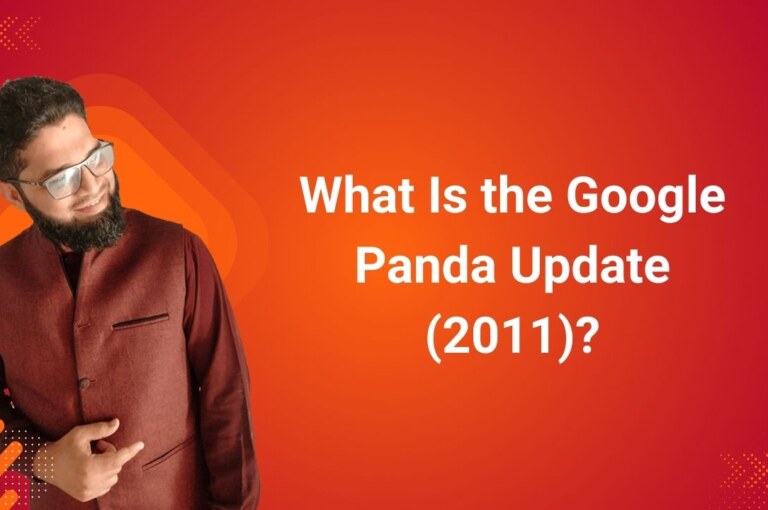What Is the Google Panda Update (2011)?
Launched in February 2011, Google Panda was a major algorithm update aimed at improving the quality of search results by penalizing low-quality content and rewarding high-value websites. Panda primarily targeted:
- Content farms: Websites producing low-quality, keyword-heavy content.
- Excessive ads: Sites with too many intrusive ads affecting the user experience.
- Duplicate content: Sites with reused or copied content.
- Low-value pages: Pages that offered little to no useful information.
Why Was the Google Panda Algorithm Introduced?
Before Panda, many websites exploited Google’s ranking system by creating thin and low-quality content designed to rank well but offer little value to users. The update was introduced to:
Improve search result quality.
Penalize sites focusing more on monetization than user experience.
Push high-value, authoritative content to the top, and demote spammy content.
How Did the Panda Update Change SEO?
The Panda Update significantly impacted SEO strategies, mainly in these areas:
1. Penalization of Low-Quality Content
Websites with thin, duplicate, or spammy content saw ranking drops.
Short, uninformative text, and over-optimized keywords got penalized.
Low-value or irrelevant content was demoted or removed from Google’s search results.
2. Boost for High-Quality Content
Websites with in-depth, well-researched content ranked higher.
Content that answered user queries thoroughly and provided real value was favored.
3. Emphasis on User Engagement Metrics
Panda factored in user signals like:
- Bounce rate (how quickly users leave the site).
- Time on site (how long users stay on the page).
- Click-through rates (CTR) from search results.
Websites with higher user engagement ranked better.
4. Demotion of Ad-Heavy Websites
Sites with more ads than actual content were penalized.
Excessive pop-ups, auto-play videos, and disruptive ads affected rankings.
What Were the Major Panda Algorithm Updates?
1. Panda 1.0 (Feb 24, 2011):
Affected 12% of search queries. Targeted content farms and ad-heavy websites.
2. Panda 2.0 – 2.5 (Apr-Sept 2011):
Extended Panda to non-English search queries.
3. Panda 3.0 – 3.9 (2012):
Enhanced detection of scraper sites and spammy content.
4. Panda 4.0 (May 20, 2014):
Affected 7.5% of English search queries.
5. Panda 4.1 (Sept 23, 2014):
Improved detection of low-quality, over-optimized content.
6. Panda 4.2 (July 17, 2015):
Slow rollout, affected content-heavy and affiliate sites.
7. Panda Becomes Part of Google’s Core Algorithm (Jan 2016):
Integrated Panda into real-time ranking systems.
How Can Websites Recover from a Panda Penalty?
To recover from Panda:
Conduct a Content Audit:
Identify and remove low-quality, duplicate, or outdated content.
Improve Content Quality:
- Write original, engaging content that provides real value to users.
- Avoid keyword stuffing—content should be naturally written.
- Add headings, bullet points, and structured information.
Reduce Ads and Improve User Experience:
- Limit intrusive ads and pop-ups.
- Optimize for fast loading times and mobile-friendliness.
- Enhance site navigation and readability.
Monitor User Engagement Metrics:
- Focus on improving bounce rates, dwell time, and click-through rates.
- Encourage user interaction through comments and social shares.
Keep Content Fresh and Updated:
- Regularly update old articles with fresh insights and information.
- Consistently publish high-quality, user-friendly content.
What Is the Current Status of Google Panda?
Since 2016, Panda became fully integrated into Google’s core ranking algorithm. This means:
No separate Panda updates: Content evaluation is now continuous.
Low-quality content is immediately devalued in real-time, rather than through periodic penalties.
How Does Panda Impact SEO Today?
1. Content Farms and Thin-Content Sites:
Content farms and thin-content sites no longer rank well.
2. User Engagement and Experience:
User experience and engagement play a crucial role in ranking.
3. E-A-T Guidelines:
E-A-T (Expertise, Authoritativeness, Trustworthiness) is crucial for ranking.
4. Excessive Ads and Poor Usability:
Websites with excessive ads and poor usability still struggle to rank.
Final Thoughts on Panda
The Google Panda Algorithm Update (2011) revolutionized SEO by:
Eliminating low-value websites from search results.
Prioritizing well-researched, high-quality content.
Setting the foundation for modern SEO, where content quality and user experience are key factors for success.
The Panda update reshaped SEO strategies by emphasizing the importance of content quality and user experience. Websites today that prioritize authentic, valuable content and user engagement are more likely to rank higher and avoid penalties.
Want to Go Deeper into SEO?
Explore more from my SEO knowledge base:
▪️ SEO & Content Marketing Hub — Learn how content builds authority and visibility
▪️ Search Engine Semantics Hub — A resource on entities, meaning, and search intent
▪️ Join My SEO Academy — Step-by-step guidance for beginners to advanced learners
Whether you’re learning, growing, or scaling, you’ll find everything you need to build real SEO skills.
Feeling stuck with your SEO strategy?
If you’re unclear on next steps, I’m offering a free one-on-one audit session to help and let’s get you moving forward.




